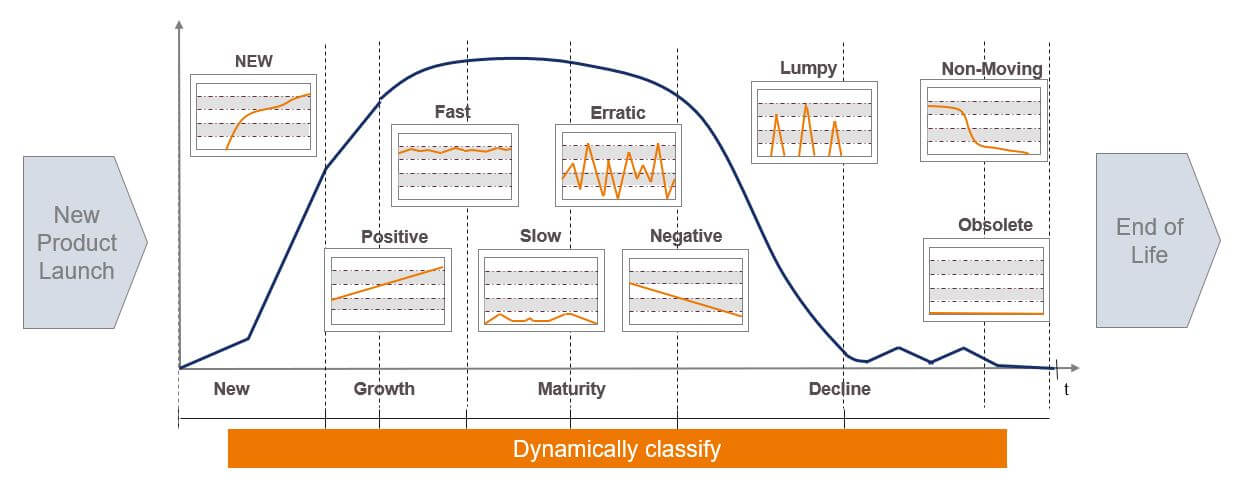The inventory planner’s guide to managing product life cycle
The product life cycle model is not only important to marketing teams and product managers; it’s also critical to any inventory planner that manages demand forecasting and stocking policies. In this blog post we’ll find out why!
Introducing inventory life cycle management
The product life cycle describes the different stages that a product goes through from the moment it gets introduced to a marketplace until it’s finally removed from sale. Inventory planning is very closely linked to the product life cycle because each stage dictates an item’s demand pattern. Inventory life cycle management is the process of treating inventory items differently by adjusting demand forecasting methods, stocking policies and reordering parameters according to where the items sit in their product life cycle.
The product life cycle and inventory management
Product life cycle management is a long-established business management technique that defines the various stages of a product in the marketplace – from market introduction to end-of-life. Almost every product has a limit to the amount of time it can successfully be sold to customers. Some products will have a shorter product life cycle, due to changing technology and consumer tastes e.g. a mobile phone or fashion item. Other products will last much longer e.g. branded groceries.
Inventory planners therefore need to know the life cycle stage for every inventory item they manage. This is to ensure stock levels reflect the associated customer demand on a continual basis. This short video will help explain:
Customer demand and the product life cycle
As a product moves through its product life cycle it will experience major changes to its demand. For example, demand could rocket during the launch stage, but drop off as it reaches decline. These differing demand patterns make it more challenging for inventory planners to forecast and ensure they’re ordering the right levels of stock.
Here is a product life cycle and the corresponding demand patterns, or ‘demand types’ that EazyStock groups items into:

As an item moves through each stage in its life cycle, it will align to a different demand type (at different times and at varying speeds). In order to ensure high accuracy, an inventory manager should use a different inventory forecasting model for each demand type. This is because in each case demand will fluctuate differently, and so the confidence interval (the range of values within which the eventual demand value is likely to be) will be greater or smaller. For example, it makes statistical sense to use a different algorithm to forecast demand for a product with ‘lumpy demand’ (with a typically high deviation from its average demand) to a product with ‘fast demand’ (with very little deviation).
Stocking policies and the product life cycle
A product’s position in the product life cycle is also critical when it comes to warehouse stocking rules. While basic inventory classification models – such as ABC analysis – group and prioritize products based on their value to the business, they fail to account for their position in the life cycle and consequential demand types. For example, if a product has previously sold well with good profit margins, you’d be inclined to hold generous amounts of stock. However, without knowing its life cycle position, you could be increasing your risk of ending up with excess and obsolete inventory. Especially if the product in nearing the end of its maturity and beginning to hit a phase of decline.
How do I manage my inventory to account for stages of the product life cycle?
1. Launch stage
The launch stage of the product life cycle is when a new product is first made available to the market. And there’s no denying it: for an inventory planning team, this is a time of high risk. Even with forecasted sales figures, no one really knows how customers will respond to the product. If customers love it, you’ll need to ramp up purchasing fast. If they hate it, you could end up with high levels of unwanted stock.
With a lack of historical demand data to support forecasting, inventory planners can look to use data from similar product launches to assist at this uncertain time.
2. Growth stage
If a new product increases in popularity, sales will start to rise. This growth could be rapid, slow or highly sporadic, but either way the trend will still be positive. As a successful inventory planner, you’ll need to run frequent demand forecasts to ensure you have the right stock levels to keep up with changing demand. You’ll also need to keep a close eye on safety stock, which can be used to support any surges in sales. With sales in a steady growth phase, it could also be wise to analyze your reorder points to optimize their cost model.
3. Maturity stage
Once a product is well established in its market, growth slows down and begins to level off. In this stage, inventory planners will typically see erratic, slow or fast demand patterns, depending on the product and its market. Again, you’ll need to carry out frequent forecasts to ensure stock levels are optimized.
As an item begins to reach the end of its maturity phase and hit decline, stock managers need to start taking action. This comes in the form of lowering the amount of inventory items you’re holding, ready for the final drop in demand. This can be done by:
- Lowering target service levels: It can be tough for companies to reduce the availability of their product to the market and risk stockouts and missed sales. But if they don’t, they could face being left with excess inventory (e.g. overstock that doesn’t have a defined customer demand) or even obsolete inventory (stock that has zero demand). And the costs associated with carrying large quantities of excess or obsolete stock can be a huge financial burden for any business. The key is to regularly re-forecast demand and make replenishment adjustments accordingly.
- Reduce safety stock levels: Your reordering frequency or replenishment levels of your safety stock should also be reduced, in accordance with the slowing demand.
4. Decline stage
As trends change and new products are released to the market, others will experience a fall in demand. Smart inventory planners will have already seen this decline on the horizon and taken action to reduce stock levels at an appropriate rate to avoid getting stuck with obsolete goods. At the very end of the product life cycle, excess and obsolete stock should be at almost zero to ensure your company’s cash isn’t tied up in inventory or lost all together.
How do I calculate the product life cycle for effective inventory planning?
Calculating the product life cycle stage of all your stocked and non-stocked items can be extremely time-consuming if you have to do it manually – especially if you have a large product portfolio! And, as previously discussed, you should ideally identify these life cycle stages and corresponding demand types on a regular basis.
If this sounds like a daunting task, consider integrating EazyStock with your business systems. As the leading inventory optimization software tool, EazyStock simply plugs into your ERP, WMS or inventory management system and automatically forecasts demand, optimizes your stock levels and recommends your replenishment requirements on a daily basis.
EazyStock not only calculates every items’ product life cycle stage and demand type; it also considers seasonality, trends and sales promotions when forecasting demand and optimum inventory levels. With data updated on a daily basis, your reorder quantities and reorder points will always be based on the latest supply and demand variables. Ready for upgraded inventory management? Contact our inventory experts here.









